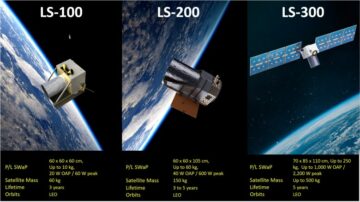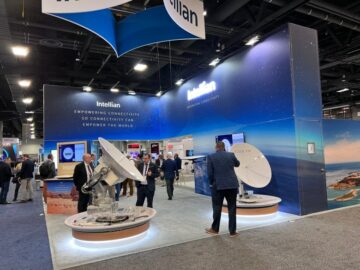WASHINGTON — CopaSAT, a supplier of communications equipment, is seeing a surge in orders for its militarized Starshield satellite terminal since its launch a few months ago.
The company, based in Seminole, Florida, designed a ruggedized satellite internet terminal that uses the Starshield electronically steered antenna built by SpaceX.
Starlink is the SpaceX satellite constellation that provides broadband internet access around the world. Consumers can purchase Starlink dishes for residential and commercial use but the system has also proven valuable for providing internet in disaster zones, aboard aircraft and ships, and for military and government applications.
SpaceX offers a Starshield version of the Starlink service that has enhanced encryption intended for government and military use.
The problem with the standard Starshield terminal is that it lacks the durability required for harsh battlefield environments, said Charlie Daniels, CopaSAT’s director of business development.
To fill that need, CopaSAT built a 30-pound militarized terminal called Storm V3 that sells for $30,000. Inside a hardened enclosure is the Starshield antenna, power systems and other components. A number of U.S. military organizations, said Daniels, have ordered about 150 terminals since the product was launched in August.
In tests, the terminals showed they can survive extreme temperatures, vibration, dust and other punishing conditions, he said. The standard Starshield dish has additional cybersecurity compared to the regular Starlink terminal, but it can’t handle the environmental conditions of military operations and when the cables break, they can’t be repaired in the field.
Other military features added
Another feature of the Storm V3 is that it can switch between AC power and batteries or DC power, a crucial feature for mobile units, said Daniels. The standard Starshield terminal only runs on AC power.
Also, standard Starshield terminals come with proprietary cables that require complete replacement if damaged. CopaSAT’s version is outfitted with military-approved connectors, allowing for battlefield repairs without needing entirely new cables.
At the request of military users, CopaSAT equipped its terminal with a SIM card slot, enabling the network to seamlessly switch between satellite and cellular service to ensure uninterrupted communication even if the satellite link is temporarily unavailable.
Daniels said CopaSAT’s road to becoming a Starshield terminal supplier was a pivot born of necessity.
Founded in 2014, the company initially built ruggedized satellite terminals using electronically steered antennas from Kymeta. But when Kymeta brought that capability in-house, CopaSAT was forced to re-evaluate its business.
The dawn of Starlink as a disruptive satellite internet service presented an opportunity for CopaSATto apply its ruggedization expertise, he said. “Starlink was just taking off and we saw there would be a demand for a militarized version that could go places the standard dish couldn’t survive.”
- SEO Powered Content & PR Distribution. Get Amplified Today.
- PlatoData.Network Vertical Generative Ai. Empower Yourself. Access Here.
- PlatoAiStream. Web3 Intelligence. Knowledge Amplified. Access Here.
- PlatoESG. Carbon, CleanTech, Energy, Environment, Solar, Waste Management. Access Here.
- PlatoHealth. Biotech and Clinical Trials Intelligence. Access Here.
- Source: https://spacenews.com/satellite-terminal-supplier-copasat-storms-into-military-market/
- :has
- :is
- 000
- 1
- 10
- 12
- 13
- 150
- 17
- 19
- 2014
- 24
- 300
- 41
- 46
- 5
- 50
- 6
- a
- About
- AC
- access
- Additional
- again
- ago
- aircraft
- Alert
- Allowing
- also
- an
- and
- antenna
- applications
- Apply
- around
- AS
- AUGUST
- based
- batteries
- Battlefield
- BE
- becoming
- between
- born
- Break
- broadband
- brought
- built
- business
- business development
- but
- button
- by
- cables
- called
- CAN
- capability
- card
- cellular
- Charlie
- Close
- come
- commercial
- Communication
- Communications
- communications equipment
- company
- compared
- complete
- components
- conditions
- connectors
- Consumers
- could
- couldn
- crucial
- Cybersecurity
- daniels
- day
- dc
- Defense
- Demand
- designed
- Development
- Director
- disaster
- dish
- dishes
- disruptive
- durability
- Dust
- electronically
- enabling
- encryption
- enhanced
- ensure
- entirely
- environmental
- environments
- equipment
- equipped
- error
- Ether (ETH)
- Even
- expertise
- extreme
- false
- Feature
- Features
- few
- field
- fill
- florida
- For
- forced
- from
- get
- Go
- Government
- handle
- hardened
- Have
- he
- Hidden
- HTTPS
- if
- in
- initially
- inside
- intended
- Internet
- internet access
- into
- IT
- ITS
- journalist
- just
- lacks
- latest
- launch
- launched
- LINK
- List
- Market
- max-width
- Military
- Mobile
- months
- necessity
- Need
- needing
- network
- New
- Newsletter
- number
- of
- off
- Offers
- on
- only
- Operations
- Opportunity
- or
- orders
- organizations
- Other
- our
- page
- Pivot
- Places
- plato
- Plato Data Intelligence
- PlatoData
- please
- pop-up
- power
- presented
- Problem
- process
- Product
- proprietary
- proven
- provides
- providing
- publish
- purchase
- RE
- regular
- repairs
- replacement
- request
- require
- required
- residential
- road
- runs
- s
- Said
- satellite
- satellite constellation
- saw
- seamlessly
- seeing
- Sells
- service
- ships
- showed
- SIM
- SIM Card
- since
- slot
- Space
- SpaceX
- standard
- starlink
- Status
- steered
- Storm
- storms
- subscription
- supplier
- surge
- survive
- Switch
- system
- Systems
- T
- taking
- Terminal
- tests
- that
- The
- the world
- There.
- they
- to
- true
- try
- Tuesday
- u.s.
- unavailable
- uninterrupted
- units
- use
- users
- uses
- using
- Valuable
- version
- veteran
- was
- we
- when
- with
- without
- world
- would
- you
- Your
- zephyrnet
- zones









